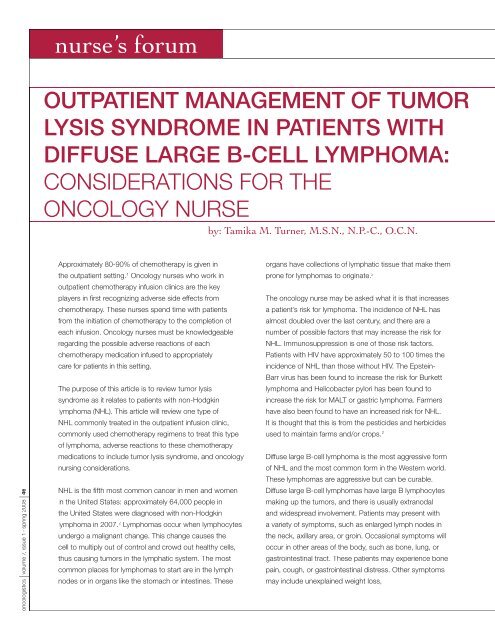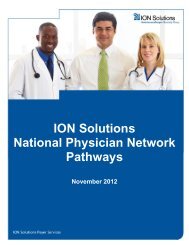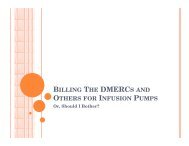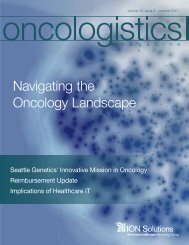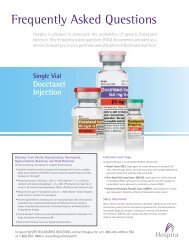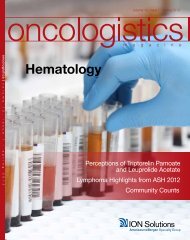First Quarter 2008 - Issues in Hematology - ION Solutions
First Quarter 2008 - Issues in Hematology - ION Solutions
First Quarter 2008 - Issues in Hematology - ION Solutions
- No tags were found...
Create successful ePaper yourself
Turn your PDF publications into a flip-book with our unique Google optimized e-Paper software.
nurse’s forumOUTPATIENT MANAGEMENT OF TUMORLYSIS SYNDROME IN PATIENTS WITHDIFFUSE LARGE B-CELL LYMPHOMA:CONSIDERAT<strong>ION</strong>S FOR THEONCOLOGY NURSEby: Tamika M. Turner, M.S.N., N.P.-C., O.C.N.oncologistics volume 7, issue 1 - spr<strong>in</strong>g <strong>2008</strong> 46Approximately 80-90% of chemotherapy is given <strong>in</strong>the outpatient sett<strong>in</strong>g. 1 Oncology nurses who work <strong>in</strong>outpatient chemotherapy <strong>in</strong>fusion cl<strong>in</strong>ics are the keyplayers <strong>in</strong> fi rst recogniz<strong>in</strong>g adverse side effects fromchemotherapy. These nurses spend time with patientsfrom the <strong>in</strong>itiation of chemotherapy to the completion ofeach <strong>in</strong>fusion. Oncology nurses must be knowledgeableregard<strong>in</strong>g the possible adverse reactions of eachchemotherapy medication <strong>in</strong>fused to appropriatelycare for patients <strong>in</strong> this sett<strong>in</strong>g.The purpose of this article is to review tumor lysissyndrome as it relates to patients with non-Hodgk<strong>in</strong>lymphoma (NHL). This article will review one type ofNHL commonly treated <strong>in</strong> the outpatient <strong>in</strong>fusion cl<strong>in</strong>ic,commonly used chemotherapy regimens to treat this typeof lymphoma, adverse reactions to these chemotherapymedications to <strong>in</strong>clude tumor lysis syndrome, and oncologynurs<strong>in</strong>g considerations.NHL is the fi fth most common cancer <strong>in</strong> men and women<strong>in</strong> the United States: approximately 64,000 people <strong>in</strong>the United States were diagnosed with non-Hodgk<strong>in</strong>lymphoma <strong>in</strong> 2007. 2 Lymphomas occur when lymphocytesundergo a malignant change. This change causes thecell to multiply out of control and crowd out healthy cells,thus caus<strong>in</strong>g tumors <strong>in</strong> the lymphatic system. The mostcommon places for lymphomas to start are <strong>in</strong> the lymphnodes or <strong>in</strong> organs like the stomach or <strong>in</strong>test<strong>in</strong>es. Theseorgans have collections of lymphatic tissue that make themprone for lymphomas to orig<strong>in</strong>ate. 2The oncology nurse may be asked what it is that <strong>in</strong>creasesa patient’s risk for lymphoma. The <strong>in</strong>cidence of NHL hasalmost doubled over the last century, and there are anumber of possible factors that may <strong>in</strong>crease the risk forNHL. Immunosuppression is one of those risk factors.Patients with HIV have approximately 50 to 100 times the<strong>in</strong>cidence of NHL than those without HIV. The Epste<strong>in</strong>-Barr virus has been found to <strong>in</strong>crease the risk for Burkettlymphoma and Helicobacter pylori has been found to<strong>in</strong>crease the risk for MALT or gastric lymphoma. Farmershave also been found to have an <strong>in</strong>creased risk for NHL.It is thought that this is from the pesticides and herbicidesused to ma<strong>in</strong>ta<strong>in</strong> farms and/or crops. 2Diffuse large B-cell lymphoma is the most aggressive formof NHL and the most common form <strong>in</strong> the Western world.These lymphomas are aggressive but can be curable.Diffuse large B-cell lymphomas have large B lymphocytesmak<strong>in</strong>g up the tumors, and there is usually extranodaland widespread <strong>in</strong>volvement. Patients may present witha variety of symptoms, such as enlarged lymph nodes <strong>in</strong>the neck, axillary area, or gro<strong>in</strong>. Occasional symptoms willoccur <strong>in</strong> other areas of the body, such as bone, lung, orgastro<strong>in</strong>test<strong>in</strong>al tract. These patients may experience bonepa<strong>in</strong>, cough, or gastro<strong>in</strong>test<strong>in</strong>al distress. Other symptomsmay <strong>in</strong>clude unexpla<strong>in</strong>ed weight loss,


